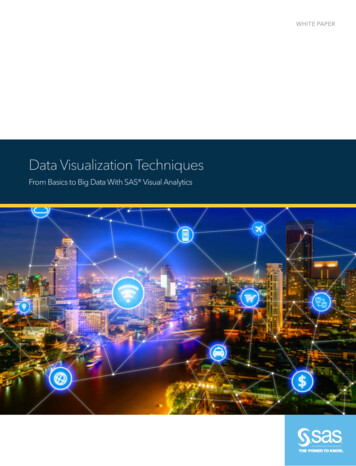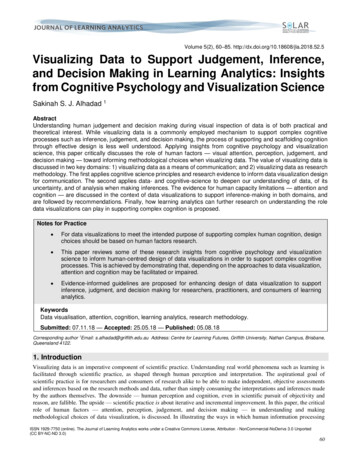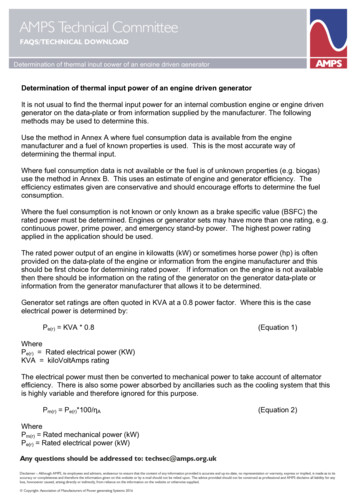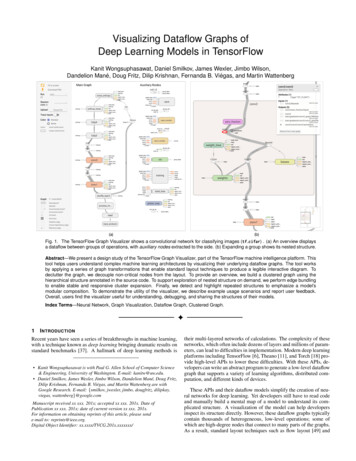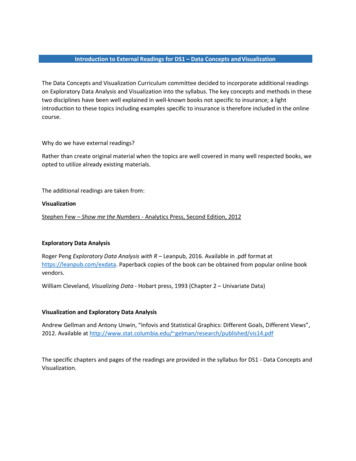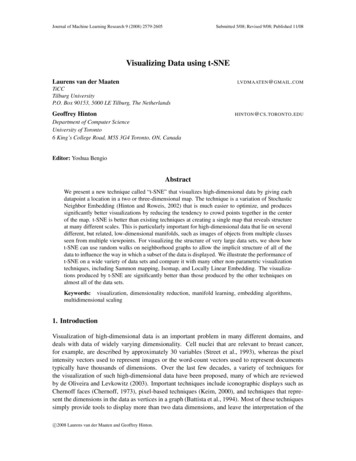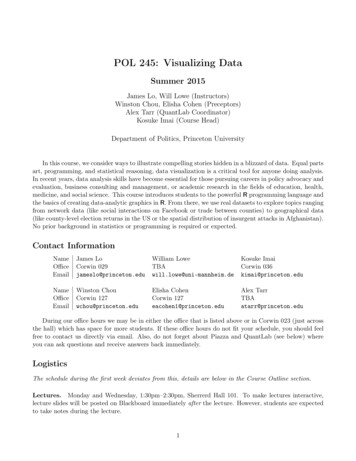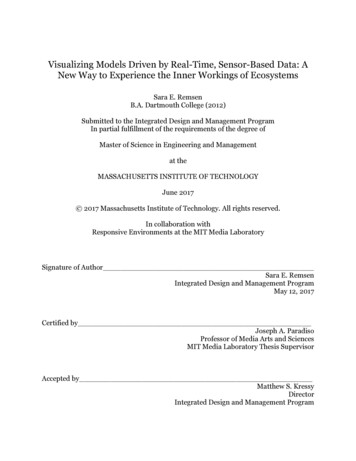
Transcription
Visualizing Models Driven by Real-Time, Sensor-Based Data: ANew Way to Experience the Inner Workings of EcosystemsSara E. RemsenB.A. Dartmouth College (2012)Submitted to the Integrated Design and Management ProgramIn partial fulfillment of the requirements of the degree ofMaster of Science in Engineering and Managementat theMASSACHUSETTS INSTITUTE OF TECHNOLOGYJune 2017 2017 Massachusetts Institute of Technology. All rights reserved.In collaboration withResponsive Environments at the MIT Media LaboratorySignature of AuthorSara E. RemsenIntegrated Design and Management ProgramMay 12, 2017Certified byJoseph A. ParadisoProfessor of Media Arts and SciencesMIT Media Laboratory Thesis SupervisorAccepted byMatthew S. KressyDirectorIntegrated Design and Management Program
This page is intentionally left blank2
Visualizing Models Driven by Real-Time, Sensor-Based Data: A New Wayto Experience the Inner Workings of EcosystemsbySara RemsenSubmitted to the program of Integrated Design andManagement, in partial fulfillment of therequirements for the degree of Master of ScienceABSTRACTThis thesis presents the human-centered design and development process for aproof-of-concept technology that visualizes models of ecosystem processes using realtime, sensor-based data. The product of this thesis, EcoFlux, provides a new way forpeople to experience the inner working of ecosystems by using augmented or virtualreality to explore unseen ecological processes. EcoFlux builds on the existing MIT MediaLab project DoppelMarsh, which is a virtual landscape that changes in response to realtime environmental conditions captured by the distributed sensor network at theTidmarsh wetland site. EcoFlux is the first of its kind to visualize models of molecularmotion and carbon flow in 3D, within the context of the physical site, and driven by realtime data. Whether experienced remotely or integrated on site, EcoFlux can be used toinspire curiosity for visitors, enhance scientific understanding for researchers, andpromote community development by demonstrating the value of ecological restoration.As environmental sensing becomes more ubiquitous in our daily lives, this thesisprovides a foundation for harnessing human sensory systems to make meaning fromabundant information.3
This page is intentionally left blank4
ACKNOWLEDGEMENTSTo my advisor Joseph A. Paradiso for inviting me to be part of this initiative, forproviding incredible insights, and for inspiring me to see the world differently.To Matthew Kressy for sharing his passion and vision for a better world through theIntegrated Design and Management program.To the Living Observatory group: Glorianna Davenport for her visionary restorationmission and for her patient wisdom throughout the project and Alex Hackman forsharing his contagious love for nature and inspiring others.To the Responsive Environments group: Gershon Dublon for his out-of-the-boxthinking and willingness to help, Spencer Russell for his support and infinitepatience, Donald Derek for his adventurous spirit and positive energy, and BrianMayton for his quiet help along the way.To Gabe Miller for his brilliant wildlife conservation efforts and for connecting mewith the Responsive Environments team in the first place.To IDM: Kevin Yuen for his amazing second opinions, Maria Tafur for herunwavering encouragement, and Ben Coble for his thoughtful insights.To my parents Bill and Jane Remsen for nurturing my curiosity and love of natureand for always supporting my dreams.To Kelly O’Brien for his support and love.5
This page is intentionally left blank6
TABLE OF CONTENTSIntroduction. 9Project Background . 14Understanding and Communicating the Value of Ecological Restoration . 15The Tidmarsh Farms Restoration Project and Living Observatory . 20DoppelMarsh Project at the MIT Media Lab. 24Project Goals . 27AR / VR as a New Medium to Communicate Information . 29Immersive Experiences: New Opportunities in AR / VR . 29Mixed Reality and Cross Reality . 29Development Opportunities and Challenges for AR and VR . 30Exploring Spatial UX: The Brave New World of Design in AR / VR . 33The Visualization of Information . 35A Framework for Information Visualization . 35Off the Page: Extruding Information Visualization into Another Dimension. 36Data “Visceralization”: Creating a Data-Driven Experience . 39Human Factors Engineering for AR / VR Information Visualization . 41Curiosity and Interactive Experience Design . 43Unexpected tools for interaction design: curiosity and beauty . 43Human-Centered Design Research and Analysis . 46The Value and Process of Human-Centered Design . 47Alignment and Learning: User Research . 49Analysis: Understanding User Needs . 51Ideation & Concept Selection . 57Concept Generation . 57Concept Selection . 59Prototyping in Unity . 62EcoFlux: Visualizing Underlying Dynamics in Molecular Motion . 64Molecular motion as a foundation for ecosystem processes . 657
Existing models for Molecular Motion . 66Cheap computation: calculating the probable velocities of gas molecules within a system . 69Experiments with particle noise to determine the best visualization techniques . 73EcoFlux: Visualizing Ecosystem Processes in Carbon Flow . 77Mathematical modeling methods for photosynthesis and respiration . 77Modeling Soil Respiration . 78Modeling Plant Respiration . 79Modeling Plant Photosynthesis . 80Key Assumptions in the Application of These Models . 82Integrating Sensor Network Data with the Mathematical Models . 85Optimizing the Performance for AR and VR to Integrate with DoppelMarsh .88Connecting the Development Process to the Original Needs List .90Future Work . 93Future of Tidmarsh . 95Foundation for Future Work . 96References. 998
INTRODUCTION“Whoever you are, no matter how lonely,the world offers itself to your imagination,calls to you like the wild geese, harsh and exciting over and over announcing your placein the family of things.”-Mary Oliver, Wild GeeseHumans’ ability to interact with the world is constrained by the physicallimitations of human sensory perception: what we can see, hear, smell, touch, or taste.However, there are endless data streams sensed by other animals that are just out ofreach of human perception, such as magnetic north, minute air currents, polarized light,or electromagnetic pulses (Figure 1). For the first time, we can begin to document someof these imperceptible elements through distributed sensor networks. Not only can wedocument environmental data, such as temperature or humidity, but we can also beginto capture how humans interact with these environments. As these sensors becomesmaller and cheaper, they will quickly become standard tools for interpreting our worldand its abundant streams of information.9
Figure 1. Every animal species possesses sensory adaptations unique to its habitat and ecologicalfunction. There are many types of information that humans cannot perceive with our natural biologicalsenses but that can be captured by new types of electrical sensors.The challenge is making meaning from this wealth of information and presentingit in an appropriate interface that utilizes existing human sensory systems. Most datatypes are meaningless to us; we cannot feel atmospheric pressure or see in ultraviolet.Presenting this data in a 2D graph enables us to analyze the data, but not to experienceit. However, with recent advances in immersive media such as augmented, mixed, andvirtual reality, there are new opportunities to communicate and make sense of this“invisible” information. We can use “data viscerlization” techniques [1] to present data10
in formats that are intuitively processed by human senses. The human brain isexceptional at processing visual information and finding patterns, so spatialvisualization is a natural method for communicating unfamiliar data streams.This thesis explores how spatial visualization techniques can be used to seeunseen processes based on real-time data inputs. This work builds on DoppelMarsh, anongoing project at the Responsive Environments group, which explores the potential ofubiquitous sensing [2]. DoppelMarsh is the result of a collaboration between theResponsive Environments group at the MIT Media Lab and the nonprofit LivingObservatory. As part of this collaboration, Responsive Environments deployed lowpower sensor nodes throughout the Tidmarsh wetland restoration landscape to collectenvironmental data in real time. This environmental data is deployed in DoppelMarsh, avirtual reality environment that changes in response to fluctuations in a connected realworld wetland. This synthetic reality can be experienced remotely or even on site at thewetland [3].The work of this thesis supports the mission of Living Observatory: to tell thelong-term story of the Tidmarsh Farms Wetland Restoration and to advance scientificknowledge and public understanding of wetland ecology [4]. Living Observatory is apublic interest learning community that complements the large-scale wetlandrestoration project at Tidmarsh Farms. Restored wetlands provide a myriad of benefits,including carbon sequestration, denitrification, and storm surge mitigation [5]. With thegoal of observing, documenting, and interpreting how freshwater wetlands change overtime, Living Observatory is uniquely suited to provide insights and create experiences11
that enable the public to witness how restoration improves the ecosystem. Itsinterdisciplinary research on the value of ecological restoration is particularly valuableas more landowners take agricultural wetlands out of production and are then facedwith a choice: real estate development or ecological restoration for their agriculturalsites.This thesis takes a human-centered design approach to understand themotivations and needs of site visitors, scientists, and the community. Human-centereddesign focuses on understanding users to design solutions that are tailored to theirneeds. Insights from in-depth qualitative interviews with important stakeholders werecrucial in making decisions throughout the product design and development process,especially in determining the desirability, feasibility, and viability of the final product.This product design and development process consisted of three major phases: researchand analysis, concept generation and selection, and finally prototyping anddevelopment.The final product of this thesis, EcoFlux, visualizes empirical models of molecularmotion, photosynthesis, and respiration within the DoppelMarsh environment (Figure2). Because these visualizations of carbon flow are driven by real-time sensor data, theychange in correspondence with the live environmental conditions of the physicalwetland. This project is the first of its kind to visualize molecular motion in 3D, in situ atthe site, and driven by real-time data. EcoFlux is a tool to explore the invisible innerworkings of ecosystems in a completely new way. These unseen ecological processes arevital to the health of an ecosystem and critical for our understanding of ecological12
restoration. DoppelMarsh and EcoFlux can be experienced in an immersive mediumsuch as augmented or virtual reality to help visitors, scientists, and the local communityunderstand the value of ecological restoration by experiencing the inner workings of theecosystem.Figure 2. The immersive experience of DoppelMarsh integrated with EcoFlux to demonstrate the unseenecological processes like carbon flow that are integral to the health and restoration of an ecosystem.13
This page is intentionally left blank14
PROJECT BACKGROUNDUNDERSTANDING AND COMMUNICATING THE VALUE OF ECOLOGICALRESTORATIONThe practice of ecological restoration rehabilitates degraded, damaged, ordestroyed ecosystems and is now an established response to biodiversity and habitatloss as the result of human activity. It is important to understand the value of ecologicalrestoration for coastal, freshwater wetlands like Tidmarsh for two reasons: functioningwetlands provide many benefits to wildlife and neighboring communities, and degradedwetlands do not return to naturally functioning wetlands by themselves.Functioning wetlands provide benefits for wildlife and human communitiesEcological restoration unlocks the many benefits that functioning ecosystemsprovide for wildlife and neighboring human communities, called ecosystem services.Ecosystem services are grouped into four categories: provisioning services, such as foodand water; regulating services, such as the control of climate and disease; supportingservices, such as nutrient cycles and crop pollination; and cultural services, such asspiritual and recreational benefits [6]. One of the primary benefits of ecosystem servicesis resilience to many of the environmental effects of climate change such as stormsurges, hurricanes, and biodiversity loss [7].A healthy, functioning wetland provides many benefits to the larger community,including carbon and nutrient cycling processes [8]. Due to the large amount ofbiomass, wetlands act as carbon sinks and can remove excess carbon dioxide from the15
atmosphere and produce oxygen instead. Wetlands are extremely important fordenitrification, the processes by which excess nitrogen is taken up by plants andremoved from the ecosystem [9]. Denitrification is a very important political topic inCape Cod, where most of the homes have septic tanks instead of municipal sewersystems. Septic tanks leach nitrogen into the surrounding areas. In wetlands andwaterways, this nitrogen can cause harmful algal blooms, setting off a chain of ecologicalresponses that usually results in “dead zones” and a loss of local biodiversity.Wetlands also provide important habitats for both aquatic and terrestrial wildlife.Wetlands are a key component of the amphibian life cycle; local species of frogs, toads,and salamanders need wetlands to lay eggs and raise aquatic offspring. Reptiles such asturtles also need freshwater habitats, and mammals like white-tailed deer browse on theshrubs that grow on the edges of the forest and the wetland. Water birds like great blueheron and snowy egret are common, but other apex predators like red-tailed hawks andsharp-shinned hawks rely on a more complex food web and will return to wetlands asbiodiversity increases.Coastal wetlands are rare and, in addition to all of the benefits of a functioningwetland, play a key role in the life cycle of many different species. For example, herringand other species of fish migrate upstream to freshwater wetlands to spawn. Herring arecritical animals in the Atlantic food web because they connect primary producers, suchas algae and zooplankton, to larger predators, such as striped bass and seals. In NewEngland, herring help sustain ocean fisheries for more desirable species, such asbluefish and tuna, which ultimately support the larger marine food web and the entire16
coastal ecosystem. Coastal wetlands also provide habitats and supporting nutrition tomigrating shorebirds. More than 50% of the original wetland for shorebirds has beendestroyed or degraded since the late 1700s, causing decreases in populations of Eskimocurlews, buffbreasted sandpipers, whimbrels, and sanderlings, to name a few [10]. As acoastal wetland, Tidmarsh plays an important role in providing foraging and stagingareas along these species’ migratory routes.Degraded wetlands do not return to functioning wetlands without humaninterventionWhen cranberry farming was first established in Massachusetts, farmers builttheir cranberry bogs, such as Tidmarsh, in existing natural wetlands. Now thatcranberry production has largely been outsourced to Wisconsin and Canada because ofeconomies of scale, new plant species, and perhaps the effects of climate change, mostMassachusetts cranberry farms are retiring. However, when cranberry farms ceaseproduction, instead of returning to their original wetland state, they transform into dryhills and forest. Although these forest ecosystems do provide benefits, natural wetlandsare rare and provide key ecosystem services that common forest ecosystems cannot.Human intervention is necessary to prevent their succession to dry forest and returnretired cranberry farms to beneficial, functioning wetlands.The value of ecosystem restoration can be demonstrated through a systemdynamics analysis (Figure 3). Climate change spurs a reinforcing loop of environmentaldegradation that decreases environmental health, which further decreases ecosystemservices and ultimately, human wellbeing. However, the more resilient an ecosystem,17
the more it can withstand the deleterious effects of climate change and balance theeffects of environmental degradation. This balancing loop of environmental resilience isactivated when ecosystems recover and can perform various ecosystem services. Thestock of cranberry bogs converts to a dry forest depending on the rate of naturalsuccession, but can be converted back to a self-sustaining wetland if restoration effortsare applied. Once a bog becomes a dry forest, it cannot be converted back to a selfsustaining wetland barring massive physical transformation, long-term geologicalprocesses, or effects of other change in the area (e.g. water table or ocean-level rise).This system dynamics model demonstrates how restoration efforts are a key driver thatsupports ecological recovery and environmental resilience in the face of environmentaldegradation from climate change.Figure 3. A system dynamics approach to environmental degradation, environmental resilience, and thevalue of ecological restoration at Tidmarsh. Restoration efforts can convert a cranberry bog to a selfsustaining wetland, which supports the balancing loop of environmental resilience.18
Because ecological restoration is so valuable, it is imperative that we tell the storyof Tidmarsh to demonstrate how ecological restoration of a wetland site provides valueto the entire watershed as well as the local community in the form of ecosystem services.The direct effects of ecological restoration are often removed from our daily lives, so it iscritical to communicate these positive benefits directly. Communicating these benefitsraises awareness in the local community, which promotes a virtuous cycle of furtherfunding and resources to support future restoration efforts. These additional causes andeffects have been outlined in a system dynamics approach (Figure 4). This thesis focuseson the exogenous input of communication of ecosystem services as the main driver forthe reinforcing loop of the value of ecological restoration, ultimately supporting thebalancing loop of Environmental Resilience to help mitigate climate change. This modelemphasizes that communicating the value of ecosystem services can be a key force in alarger system.19
Figure 4. The addition of the exogenous factor communication of ecosystem services supports a newreinforcing loop of ecological restoration that enables the balancing loop of environmental resilience inresponse to the environmental degradation from climate change. The human-centered design process isused as a tool to understand how to best communicate ecosystem services in order to help allstakeholders understand the value of ecosystem services.THE TIDMARSH FARMS RESTORATION PROJECT AND LIVINGOBSERVATORYTidmarsh Farms is a 600-acre retired cranberry farm located in Plymouth,Massachusetts. The farm was originally built in the early 1900s and was in operationuntil 2010, when the current owner ceased farming and founded the Tidmarsh FarmsRestoration Project to transition the decommissioned farm to a natural wetland system.As one of the few wetland systems so close to the coast of Cape Cod, Tidmarsh plays animportant role in dynamics of the Eel River and Plymouth Harbor watersheds.Tidmarsh will serve as a critical conservation site both as a buffer to rising sea levels and20
as a habitat for wildlife including amphibians, reptiles, mammals, and bird species suchas snowy egrets, marsh wrens, and American bitterns.The Tidmarsh Farms Restoration Project is part of an initiative called the LivingObservatory [11]. The Living Observatory (LO) is a learning collaborative of scientists,artists, and wetland restoration practitioners. Its goal is to document, interpret, andreveal ecological change prior to, during, and following the Tidmarsh Farms RestorationProject, the largest freshwater wetland restoration project to date in Massachusetts(Figures 5 and 6). As a result of these efforts, the eastern section of Tidmarsh became apriority project for Massachusetts Department of Fish and Game’s Division of EcologicalRestoration (DER). The goal of the restoration project was to create a biologically andphysically diverse, sustainable, freshwater wetland that enables wildlife to pass from theheadwaters to the ocean. As of May 2017, Mass Audubon hopes to turn Tidmarsh Eastinto a wildlife sanctuary [12].21
Figure 5. USGS map with overlay, courtesy Living Observatory Archive.Figure 6. Google map with overlay, courtesy Living Observatory Archive.22
Documenting Restoration Efforts and the Subsequent Ecological ChangeIn an effort to convert Tidmarsh to a healthy wetland, Living Observatoryinstituted large-scale restoration projects throughout the site (Figure 7). As a first stepto restoring the natural processes of a self-sustaining wetland, stream channels weredug out to match historical records of the pre-cranberry bog water flow. Several pondswere carved out to provide a variety of habitats to wildlife and echo the original wetland.The peat mat was broken up and the topsoil was overturned, enabling growth from thedormant seed bank. Organic matter such as tree branches was added to the site toaccelerate natural nutrient cycling processes. Through a specific plant program, nativespecies were reintroduced to the area to support the return to a self-sustaining wetland.Figure 7. InterFluve, Inc. 100% Engineering Drawing, courtesy Living Observatory Archive.23
The Tidmarsh restoration project represents a unique opportunity to documentthe post-restoration ecological change with environmental sensors and demonstrate thevalue of wetland restoration to the local community. This multi-sensory observationproject provides valuable, never-been-seen data to support research and explorationinto our understanding of hydrology, stream ecology, soil science, and otherapplications for environmental sensing. These data are made available to the entire LOgroup to enhance collaborative learning across disciplines. The mission of LO is to “tellthe long-term story of the Tidmarsh Farms Wetland Restoration and to advancescientific knowledge and public understanding of wetland ecology.” LO also provides theopportunity to teach effective strategies for reducing the impact of climate change,including minimizing environmental stressors such as invasive species and residentialdevelopment, increasing habitat diversity, and connecting protected landscapes [13].DOPPELMARSH PROJECT AT THE MIT MEDIA LABThe MIT Media Lab group Responsive Environments began collaborating withthe Living Observatory and the Tidmarsh project in an effort to use technology todocument the impact of freshwater ecological restoration. Responsive Environmentsdesigned and built a system of small, distributed, low-power sensors that measure theenvironmental conditions in the marsh, such as temperature, humidity, pressure, andilluminance. Microphones stream audio from the trees and underwater. These sensornetworks help document ecological changes and allow people to experience the data atdifferent spatial and temporal scales. For the first time, this sensor network enables24
visitors to experience an environment and its processes in a way that goes beyond thelimitations of our human sensory inputs. This project is detailed here [14].DoppelMarsh is the flagship project that integrates sensor data input with adigital version of Tidmarsh. It is a cross-reality sensory landscape constructed using theUnity game engine to experiment with presence and multimodal sensory experiences[15] [16]. DoppelMarsh enables visitors to experience and explore the Tidmarshdifferently based on the real-time sensor data. For example, a visit to DoppelMarsh inthe afternoon will be different from a visit to DoppelMarsh at midnight.The sensor network at Tidmarsh forms a mesh network based on the IEEE802.15.4 specifications. This network is built from approximately 100 low-power nodes,which contain a variety of sensors that monitor environmental parameters and whichstream thousands of data points to a server twice per minute, 24 hours a day. Thesesensors were designed by Responsive Environments Research Assistant Brian Maytonso that additional environmental metrics (e.g. soil moisture) can be easily added in thefuture [17]. Data are relayed to a base station via a wireless mesh network and thenuploaded to a remote server, where data are then streamed to the virtual environmentvia the ChainAPI server (Figure 8) [18]. The client is DoppelMarsh, an application builtwith Unity that can run locally on any machine.25
Figure 8. Data are collected via low-power sensor nodes, relayed to a base station via a wireless meshnetwork, and then uploaded to a remote server, where data are then streamed to the virtualDoppelMarsh environment via the ChainAPI server. These data are then used to drive models of carbonflow.Several previous projects have explored different interface modalities to createnovel experiences based in the real-time sensor network data. In 2013, the DoppelLabproject created a new way to communicate sensor data by combining spatializedsonification with animated data visualization in a 3D virtual environment representingthe MIT Media Lab itself [19]. In the DoppelLab environment, a visitor could exploreboth real-time and archived data remotely. DoppelLab was one of the firstimplementations of a cross-reality environment [20] and acted as inspiration for thefuture DoppelMarsh project.Responsive Environments has continued to build functionality for DoppelMarshto explore how additional information about the environment affects visitors’ perceptionof “presence” at Tidmarsh. HearThere developed a spatial, auditory augmented realitythat preserves the alignment be
May 12, 2017 · visualization is a natural method for communicating unfamiliar data streams. This thesis explores how spatial visualization techniques can be used to see unseen p


